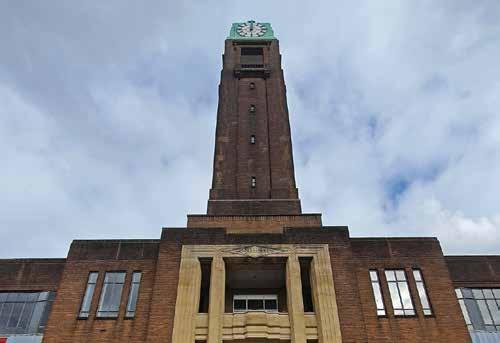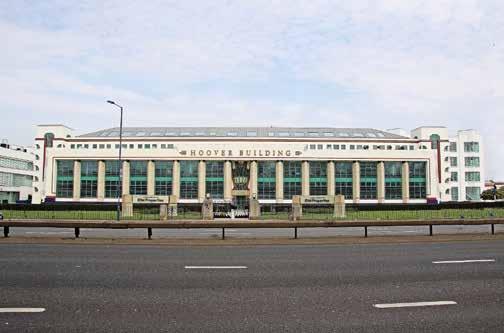
6 minute read
Industrious Ealing
By Anthony Warwick-Ching
Queen of the suburbs or city of a thousand trades? Ealing’s crown may have slipped just a bit, but it has remained surprisingly industrious. Recent figures show that in 2019 almost nine per cent of its workforce was in manufacturing. True, the headcount of 12,000 is a fraction of the numbers once involved in industry, but as a share of total employment it’s nearly four times the average for London (2.3%) and even higher than the figure (8%) for the country as a whole.
Advertisement
More remarkably, the past decade has actually seen growth. Between 2010 and 2015 manufacturing jobs rose by a third in Ealing at a time when they were falling or stagnating in the rest of London. And since then – at least till Coronavirus hit - it has held on to those gains.
The Factory Mile
Ealing is fortunate to have a strong industrial heritage. Though the roots go back to Edwardian times the mainspring was the growth of the London economy in the 1920s and 30s. Import protection fostered engineering, a new National Grid fuelled demand for electrical goods and convenience foods had caught on. West London flourished, with dozens of US firms setting up operations. Ealing and its neighbours got the Factory Mile on the Great West Road and new developments along the A40, with newcomers such as Firestone, Pyrene, Hoover, Gillette, Guinness and Heinz commissioning distinguished architects to design their factories.
The picture remained buoyant through the war and well beyond. True, the trend faltered in the 1970s, when there were one or two notable closures. AEC, maker of the Routemaster for London Transport, closed in Southall in 1979, with the loss of several thousand jobs, and Park Royal Vehicles followed soon after. Yet at 3.5% Ealing’s unemployment rate stayed below the UK national average.
1980s Cutbacks
All this changed in the 1980s. Hammered by record interest rates, an overvalued pound and crippling recession dozens of firms made sweeping cutbacks. From an average 10,000 a year in the late 1970s, redundancies in the GLC area jumped to five times that level in 1981 and higher still in succeeding years. West London bore the brunt. Unemployment shot up to 11.6% for Ealing as a whole and approached 20% in Southall. Economic recovery brought some relief, only for renewed recession to bring a surge in unemployment at the end of the decade.
Where were those jobs lost? One of the biggest sources was Park Royal. Shared by Ealing and Brent and similar in area to the City of London, Park Royal opened as an agricultural showground in the 1900s but soon converted to manufacturing. Early activities included iron-making, munitions and rubber processing, but after the First World War more salubrious operations predominated and Park Royal became a legend as one of the largest industrial estates in the country. The 1920s saw Park Royal Vehicles, Heinz Foods, Rank, Landis & Gyr and British Can established, and they were followed in the 1930s by Guinness, Waterlow, Elizabeth Arden and dozens of smaller ventures.
Automobile and aircraft engineering, electrical engineering and food processing predominated, and the picture remained much the same after the war. By 1952 Park Royal had five operations with more than 1,000 employees, with Heinz the largest at over 1,500. The sunny years of never had it so good brought further expansion and by the mid60s employment had reached an astonishing 45,000, including no fewer than 3,500 at Heinz. Even after the rationalisations of the 1970s there were still 30,000 working on the estate.
All this changed in the 1980s, when casualties multiplied. One of the first was Hoover, in neighbouring Perivale, which shut in 1982. By middecade alarm bells were ringing, but Ealing Acton MP George Young angrily rejected fears that even Heinz and Guinness might go. His wiser constituents, perhaps mindful of the advice never to believe a report until there is an official denial, were unsurprised when Heinz did eventually close. The bicycling baronet (no, it wasn’t an early conversion to healthier living, but a drink-drive ban) went off to take his place among the unelected members of the mother of parliaments.
Park Royal Revival in the 2000s
Park Royal revived in the 2000s and despite residential encroachment it has largely retained its commercial character. The big factories have been replaced by smaller factories, warehouses and workshops. Unfortunately an initiative to promote the area, the Park Royal Partnership, was foolishly killed off by public spending cuts in 2014. Parts of the estate are a ghost of what was. Park Royal Leisure Park, just south of the A40, is now just tumbleweed.
Closely linked to the development of Park Royal was central Acton, which attracted new industries from the early 1900s. Again electrical engineering and motor manufacture predominated. One of the most famous operations was that of Napier, established in 1903. Celebrated for high speed cars Napier built the world’s first factory for six cylinder engines at its premises just off Acton Vale and chased land speed records between the wars. Firms like Napier were nothing if not versatile and like their Park Royal peers turned to aircraft during the Second World War. After it closed in 1963 the Napier site became Acton Park industrial estate.
Rivalling Napier in fame was CAV, founded by Charles Vandervell in Warple Way in 1904. Near neighbours in the early years included Panhard & Lavasseur, Talbot, W&G du Cros and Renault. Originally specialising in vehicle lighting, CAV was taken over by Lucas and concentrated on diesel technology and aircraft fuelling. The 1950s brought diversion into motor racing and victories in six out of ten championship races in 1958. The Acton operation finally succumbed to the recession of the early 1980s. Other former residents of Acton included Wall’s in foods, Bronnley toiletries in Warple Way and the last redoubt of Broadwood, once a world leader in pianos.
Ealing’s earliest brush with modern industry was in Greenford, where the world’s first artificial dye works was established by William Henry Perkin in the 1850s. But it was not until the 1900s that significant manufacturing arrived in the form of the WA Bailey glassworks, forerunner of Rockware Glass. The inter-war years brought a very big Lyons tea-blending operation and Glaxo baby foods and pharmaceuticals. Both have now gone, leaving Brompton Bicycles to carry Greenford’s flag for manufacturing.
Southall for Food
Southall perhaps has the longest attachment to food of all Ealing’s neighbourhoods. 1893 set the pace with a huge new margarine works. This evolved into a large Walls/Birds Eye factory and the charmingly named Margarine Road became Bridge Road. Other big food operations have included Quaker Oats, Nestle and, more recently, Noon Products and TRS Foods, which are still thriving. Serving these and other food and beverage makers was Crown Cork, which closed in the 1980s.
The rest of Ealing was not entirely outdone. Wolf Electric Tools opened on Hanger Lane in 1935 and survived until the 1980s. Ottway made military instruments on New Broadway until the late 1960s. And in 1916 West Ealing actually produced a tank at a workshop on Talbot Road. It was not adopted by the War Office, however, and ended its days as a rusting hulk in Dean Gardens.
Somehow the Allies managed to win the war without it.
Editor’s Note:
Anthony Warwick-Ching is a local economist.
His book: Stolen Heritage: The Strange Death of Industrial England, published 2020 by Matador ISBN 978 1838593 988 is available from bookshops and online retailers.

Hoover Building on Western Avenue








